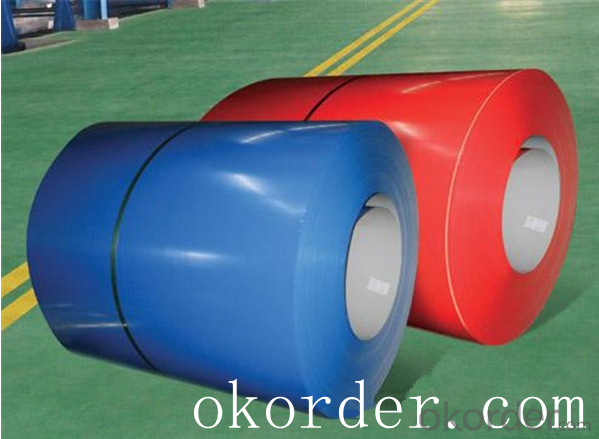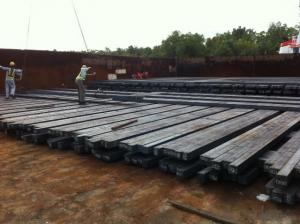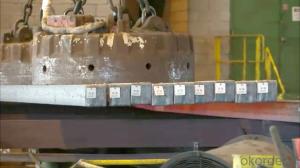Prime quality prepainted galvanized steel 740mm
- Loading Port:
- Tianjin
- Payment Terms:
- TT OR LC
- Min Order Qty:
- 100 m.t.
- Supply Capability:
- 10000 m.t./month
OKorder Service Pledge
OKorder Financial Service
You Might Also Like
Construction building material galvanized color prepainted cold
rolled steel coil
Prepainted steel sheet is coated with organic layer, which provides higher anti-corrosion property and
a longer lifespan than that of galvanized steel sheets.
The base metals for prepainted steel sheet consist of cold-rolled, HDG electro-galvanized and hot-dip
Alu-zinc coated. The finish coats of prepainted steel sheets can be classified into groups as follows:
polyester, silicon modified polyesters, polyvinylidene fluoride, high-durability polyester, etc

Standard and Grade :
Pre-paint galvanized steel coil | ||||
ASTM A755M-03 | EN10169:2006 | JISG 3312-2012 | ||
Commercial quality | CS | DX51D+Z | CGCC | |
Structure steel | SS GRADE 230 | S220GD+Z | CGC340 | |
SS GRADE 255 | S250GD+Z | CGC400 | ||
SS GRADE 275 | S280GD+Z | CGC440 | ||
SS GRADE 340 | S320GD+Z | CGC490 | ||
SS GRADE550 | S350GD+Z | CGC570 | ||
S550GD+Z | ||||
Application:
Outdoor | Roof, roof structure, surface sheet of balcony, frame of window, door of garage, rolled shutter door, booth, Persian blinds, cabana, etc |
Indoor | Door, isolater, frame of door, light steel structure of house, home electronic appliances, ect. |
Specifications
Commodity Name: Prepainted Galvanized Steel Coil
Standard: AISI, ASTM, DIN, GB, JIS
Grade: TDC52D+Z
Thickness 0.13-8.0mm
Width:600mm-1350mm
Zinc Coating:275g/m2
Polyester Coating Thickness:Top and Back coating thickness depend by Buyer Requirement.
Polyester Coating Type:2/2,1/2m,1/2.
Polyester Type: Polyester, silicone modified polyester, high durability polyester (HDP), polyvinylidene fluoride (PVDF)
Unit Roll Weight:5-20tons
Place of Origin Shanghai , China (Mainland)
Surface Treatment :Color Coated
Manufacture Progress:HRC-CRC-GALVANIZED-COLOR COATED
Application : Construction, electrical, transportation, steel plant, composite board plant, steel tile factory
Payment & Shipping Terms:T/T ,L/C, and FOB CHINA
Minimum Order Quantity: 25Tons
Packge Type: Moisture-proof paper inner,Steel outside,Bundle by steel rope.
Package in Container : Wood as a foot pad, wire rope reinforcement,PPGI steel coil tied together by steel rope.
- Q:How are steel billets used in the manufacturing of structural steel?
- Steel billets are a crucial raw material in the manufacturing of structural steel. They are heated, shaped, and then cooled to form various steel products such as beams, columns, and plates. These billets serve as the starting point for the production process, where they are further processed and transformed into different shapes and sizes to meet the specific requirements of construction projects.
- Q:How are steel billets used in the production of agricultural machinery?
- Steel billets are used in the production of agricultural machinery as a raw material for various components such as gears, shafts, and frames. These billets are melted and molded into the desired shape, providing the necessary strength and durability required for the machinery to effectively perform tasks in the agricultural sector.
- Q:What are the different methods of steel billet surface coating?
- There are several methods of steel billet surface coating that are commonly used in various industries. These methods aim to enhance the durability, corrosion resistance, and appearance of the steel billets. Some of the different methods of steel billet surface coating include: 1. Hot-dip galvanizing: This method involves immersing the steel billets in a bath of molten zinc. The zinc forms a protective layer on the surface of the steel, providing excellent corrosion resistance. Hot-dip galvanizing is widely used in construction, automotive, and infrastructure industries. 2. Electroplating: In this method, an electric current is used to deposit a thin layer of metal, such as chromium or nickel, onto the surface of the steel billets. Electroplating improves the appearance of the steel and provides a protective coating against corrosion. 3. Powder coating: Powder coating involves electrostatically spraying a dry powder onto the surface of the steel billets. The powder is then cured using heat, which forms a hard, durable, and attractive coating. Powder coating provides excellent resistance to impact, corrosion, and chemicals. 4. Painting: Steel billets can be coated with paint using various techniques such as spraying, dipping, or brushing. Paint coatings not only enhance the appearance of the steel but also provide protection against corrosion and weathering. 5. Thermal spray coating: This method involves projecting molten or semi-molten materials onto the surface of the steel billets. The materials can be metals, ceramics, or polymers, which form a coating upon solidification. Thermal spray coatings provide excellent corrosion resistance, wear resistance, and thermal insulation. 6. Anodizing: Anodizing is commonly used for aluminum, but it can also be applied to steel billets. In this process, the steel billets are immersed in an electrolyte solution and subjected to an electric current. This creates a controlled oxidation reaction on the surface, forming a protective layer of oxide. Anodizing improves the corrosion resistance and appearance of the steel. Each of these methods has its own advantages and is suitable for specific applications. The choice of coating method depends on factors such as the intended use of the steel billets, environmental conditions, and desired properties of the coating.
- Q:How do steel billets contribute to the manufacturing of textile machinery?
- Steel billets play a crucial role in the manufacturing of textile machinery as they are used as raw materials for creating various components and parts. These billets are transformed into different shapes and sizes through processes like casting, forging, and machining to form the necessary components of textile machinery such as gears, shafts, frames, and bearings. The high strength and durability of steel billets ensure that the textile machinery is capable of withstanding heavy loads, high speeds, and continuous operation, resulting in efficient and reliable performance in the textile industry.
- Q:How are steel billets used in the manufacturing of castings?
- Steel billets are used in the manufacturing of castings as a raw material that is heated and melted to create the molten metal for casting. The billets are then poured into molds to form the desired shape, which is later solidified and cooled to obtain the final casting product.
- Q:What are the different quality control measures for steel billets?
- There are several quality control measures that are implemented during the production and inspection of steel billets to ensure their high quality. These measures include: 1. Chemical Composition Analysis: The chemical composition of steel billets is thoroughly analyzed to ensure it meets the required specifications. This analysis involves determining the content of various elements such as carbon, manganese, sulfur, phosphorus, and others. Any deviations from the specified composition can affect the mechanical properties of the billets. 2. Dimensional Inspection: Steel billets undergo dimensional inspection to verify their size, shape, and weight. This involves measuring the length, width, and thickness of the billets using precision instruments and ensuring they meet the specified tolerances. Any deviations from the required dimensions can impact the performance of the billets during subsequent processing. 3. Surface Inspection: The surface of steel billets is inspected for any defects or irregularities. This includes checking for cracks, surface discontinuities, surface roughness, and other imperfections. Surface inspection is typically conducted using visual inspection techniques or non-destructive testing methods such as magnetic particle testing or ultrasonic testing. 4. Mechanical Testing: Mechanical testing is performed to assess the mechanical properties of steel billets. This includes conducting tests such as tensile testing, hardness testing, and impact testing to determine the strength, ductility, toughness, and other mechanical characteristics of the billets. These tests ensure that the billets possess the required mechanical properties for their intended applications. 5. Metallurgical Examination: Metallurgical examination involves studying the microstructure of steel billets through microscopic analysis. This examination helps identify any defects in the metal structure, such as grain size, segregation, inclusions, or improper heat treatment. By assessing the metallurgical properties, the quality control team can ensure that the billets are free from any internal defects that might compromise their structural integrity. 6. Non-Destructive Testing (NDT): Non-destructive testing techniques, such as ultrasonic testing, magnetic particle testing, or eddy current testing, are used to detect internal defects or discontinuities that may not be visible through visual inspection. These methods allow for the detection of flaws without damaging the billets, ensuring their integrity is maintained. 7. Documentation and Traceability: Quality control measures also include maintaining proper documentation and traceability throughout the production process. This includes documenting the results of all inspections, tests, and analyses performed on the steel billets, as well as tracking their origin, processing history, and any relevant certifications. This documentation ensures transparency and enables traceability in case of any quality-related issues. By implementing these quality control measures, steel manufacturers can ensure that the produced billets meet the required specifications, possess the desired properties, and are of high quality, thereby enhancing their reliability and suitability for various applications in industries such as construction, automotive, and manufacturing.
- Q:What are the different types of surface defect detection methods for steel billets?
- There are various types of surface defect detection methods used for steel billets. Some of the commonly employed techniques include visual inspection, magnetic particle inspection, ultrasonic testing, eddy current testing, and laser scanning. 1. Visual Inspection: This is the simplest and most traditional method, where trained inspectors visually examine the surface of steel billets for any signs of defects such as cracks, scratches, or foreign material. 2. Magnetic Particle Inspection (MPI): MPI is a non-destructive testing method that uses magnetic fields and iron particles to detect surface defects. The billet is magnetized, and iron particles are applied to the surface. Any defect causes a leakage of magnetic flux, attracting the iron particles and forming visible indications. 3. Ultrasonic Testing (UT): UT involves the use of high-frequency sound waves to detect internal and surface defects in steel billets. A transducer emits ultrasonic waves into the billet, and the reflected waves are analyzed to identify any flaws or irregularities. 4. Eddy Current Testing (ECT): ECT utilizes electromagnetic induction to detect surface defects. A coil carrying an alternating current is placed near the billet's surface, which generates eddy currents. Any variation in the surface, like cracks or corrosion, alters the eddy currents, and this change is detected by the instrument. 5. Laser Scanning: Laser scanning is a relatively advanced method that uses laser technology to scan the surface of steel billets. The laser beam reflects off the surface, and a sensor analyzes the reflected light to identify any surface defects, such as scratches or dents. These different methods vary in terms of their sensitivity, speed, and cost-effectiveness. The choice of the appropriate surface defect detection method depends on factors such as the required level of accuracy, the type of defects to be detected, and the specific industry requirements.
- Q:What is the role of steel billets in the manufacturing of structural steel buildings?
- Steel billets play a crucial role in the manufacturing of structural steel buildings. These billets, which are semi-finished forms of steel, serve as the primary raw material for the production of various steel products used in construction. Firstly, steel billets are used to produce long steel products such as beams, columns, and rods. These components form the skeletal structure of buildings, providing support and stability. By shaping and processing the steel billets through processes like rolling, forging, or extrusion, manufacturers can create these essential structural elements. The high strength and durability of steel make it an ideal material for constructing buildings that can withstand heavy loads and adverse environmental conditions. Furthermore, steel billets are also used to manufacture other crucial components like plates and sheets, which are used for flooring, roofing, and cladding in structural steel buildings. These flat steel products provide a protective and aesthetically pleasing finish to the building, while also contributing to its overall strength and stability. The consistent quality and uniformity of steel billets ensure that the resulting structural steel components have the required mechanical properties, such as tensile strength and ductility, to meet the safety and performance standards demanded by construction projects. Steel billets are often produced using advanced manufacturing techniques, such as continuous casting, which further enhances the quality and reliability of the final steel products. In summary, steel billets are essential in the manufacturing of structural steel buildings as they serve as the raw material for producing various components like beams, columns, plates, and sheets. These components form the framework and protective elements of the building, providing strength, stability, and durability. Through careful processing and quality control, steel billets enable the production of high-quality steel products that meet the stringent requirements of the construction industry.
- Q:How do steel billets contribute to the water treatment industry?
- Steel billets are used in the water treatment industry to manufacture various components such as pipes, valves, and fittings. These components are vital for the construction and maintenance of water treatment infrastructure. Steel billets provide the necessary strength, durability, and corrosion resistance needed to withstand harsh conditions and chemicals involved in water treatment processes. Thus, steel billets play a crucial role in ensuring the efficiency and longevity of water treatment systems.
- Q:Refinery carbon 3 is propane, then carbon four carbon five is what name ah?.What are they used for?
- Carbon four is butane, C4H10 carbon five is pentane C5H12
1. Manufacturer Overview |
|
|---|---|
| Location | |
| Year Established | |
| Annual Output Value | |
| Main Markets | |
| Company Certifications | |
2. Manufacturer Certificates |
|
|---|---|
| a) Certification Name | |
| Range | |
| Reference | |
| Validity Period | |
3. Manufacturer Capability |
|
|---|---|
| a)Trade Capacity | |
| Nearest Port | |
| Export Percentage | |
| No.of Employees in Trade Department | |
| Language Spoken: | |
| b)Factory Information | |
| Factory Size: | |
| No. of Production Lines | |
| Contract Manufacturing | |
| Product Price Range | |
Send your message to us
Prime quality prepainted galvanized steel 740mm
- Loading Port:
- Tianjin
- Payment Terms:
- TT OR LC
- Min Order Qty:
- 100 m.t.
- Supply Capability:
- 10000 m.t./month
OKorder Service Pledge
OKorder Financial Service
Similar products
New products
Hot products
Related keywords

































